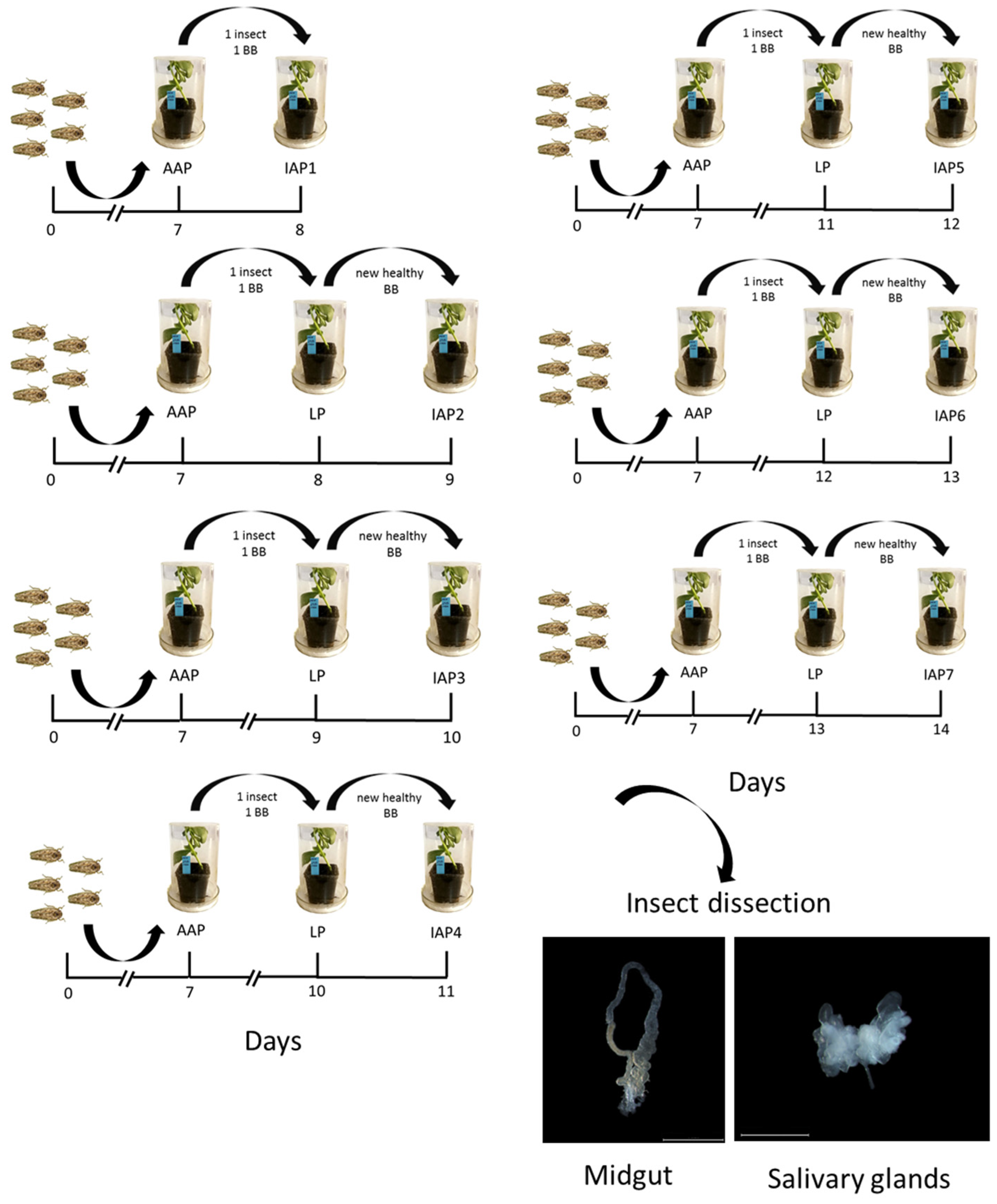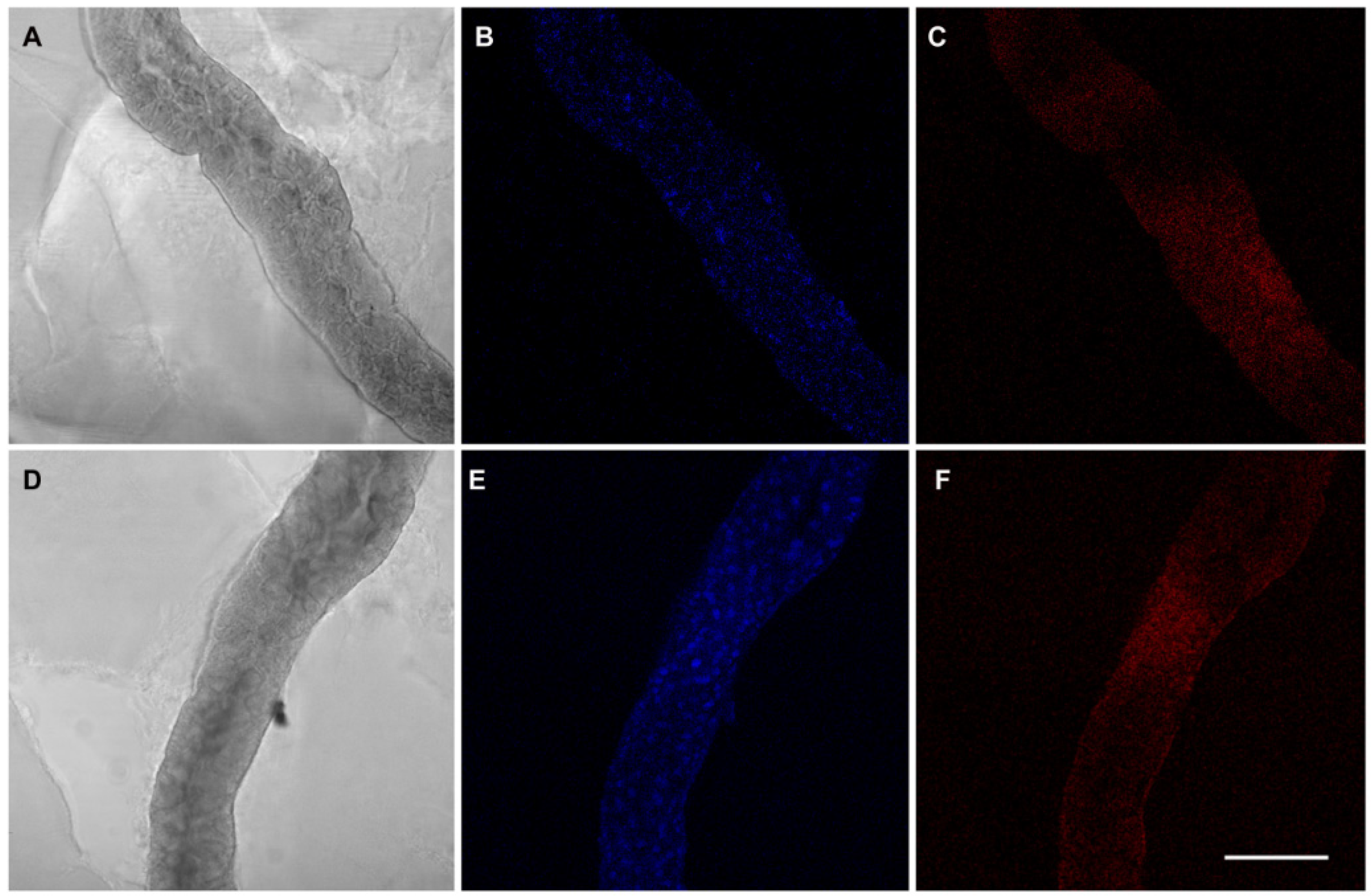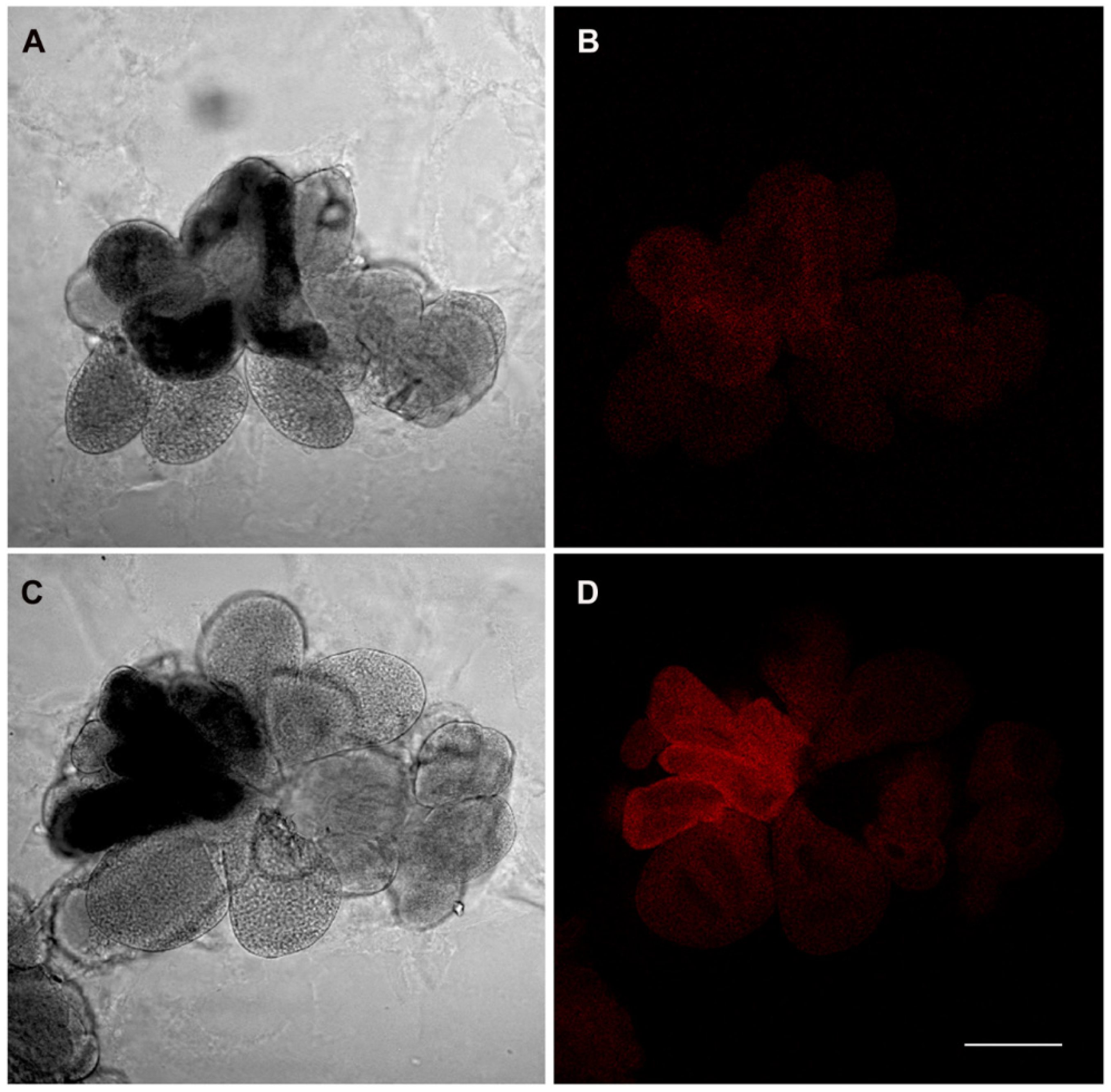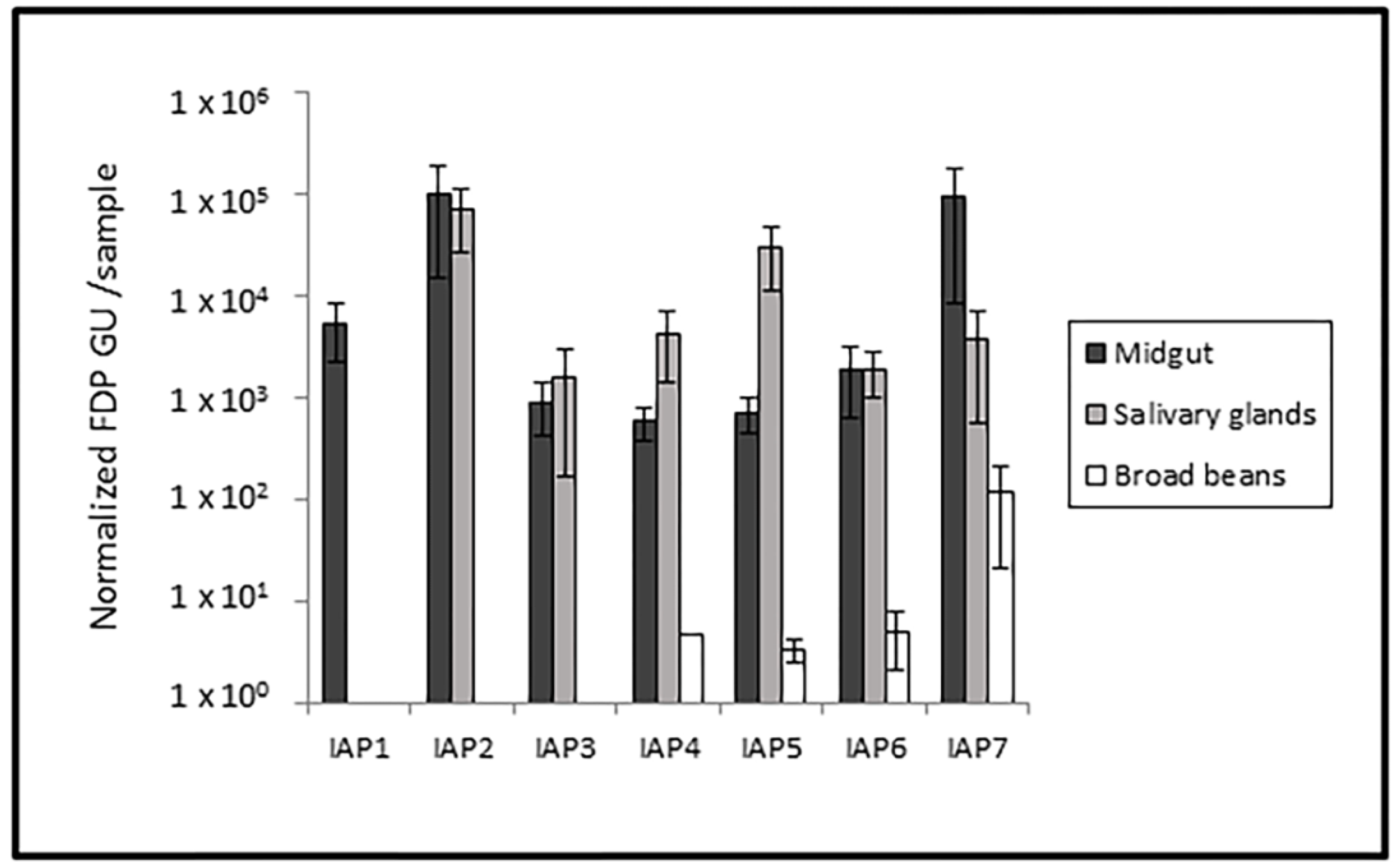Ability of Euscelidius variegatus to Transmit Flavescence Dorée Phytoplasma with a Short Latency Period
Simple Summary
Abstract
1. Introduction
2. Materials and Methods
2.1. Insect and Plant Material
2.2. Transmission Experiments
2.3. DNA Extraction and Quantitative Real-Time PCR Analysis
2.4. Fluorescent In Situ Hybridization (FISH)
2.5. Statistical Analysis
3. Results
4. Discussion
5. Conclusions
Author Contributions
Funding
Acknowledgments
Conflicts of Interest
References
- Marcone, C. Molecular biology and pathogenicity of phytoplasmas. Ann. Appl. Biol. 2014, 165, 199–221. [Google Scholar] [CrossRef]
- Foissac, X.; Wilson, M.R. Current and possible future distributions of phytoplasma diseases and their vectors. In Phytoplasmas: Genomes, Plant Hosts and Vectors; CAB International: Wallingford, UK, 2010; pp. 309–324. [Google Scholar]
- Seemüller, E.; Marcone, C.; Lauer, U.; Ragozzino, A.; Göschl, M. Current status of molecular classification of the phytoplasmas. J. Plant. Pathol. 1998, 80, 3–26. [Google Scholar]
- Marzachì, C.; Milne, R.G.; Bosco, D. Phytoplasma-plant vector relationships. In Recent Research Development in Plant Pathology; Research Signpost: Trivandrum, Kerala, India, 2004; pp. 211–241. [Google Scholar]
- Bertaccini, A.; Duduk, B.; Paltrinieri, S.; Contaldo, N. Phytoplasmas and phytoplasma diseases: A severe threat to agriculture. Am. J. Plant Sci. 2014, 5, 1763–1788. [Google Scholar] [CrossRef]
- Purcell, A.H. Insect vector relationships with prokaryotic plant pathogens. Annu. Rev. Phytopathol. 1982, 20, 397–417. [Google Scholar] [CrossRef]
- D’Arcy, C.; Nault, L.R. Insect transmission of plant viruses and mycoplasmalike and rickettsialike organisms. Plant Dis. 1982, 66, 99–104. [Google Scholar] [CrossRef]
- Weintraub, P.G.; Beanland, L.A. Insect vectors of phytoplasmas. Annu. Rev. Entomol. 2006, 51, 91–111. [Google Scholar] [CrossRef] [PubMed]
- Alma, A.; Tedeschi, R.; Lessio, F.; Picciau, L.; Gonella, E.; Ferracini, C. Insect vectors of plant pathogenic Mollicutes in the European-Mediterranean region. Phytopathogenic Mollicutes 2015, 5, 53–73. [Google Scholar] [CrossRef]
- Chiykowski, L.N.; Sinha, R.C. Sex and age of Macrosteles fascifrons in relation to the transmission of the clover proliferation causal agent. Ann. Entomol. Soc. Am. 1970, 63, 1614–1617. [Google Scholar] [CrossRef]
- Swenson, K.G. Relation of age, sex and mating of Macrosteles fascifrons to transmission of aster yellows. Phytopathology 1971, 61, 657–659. [Google Scholar] [CrossRef]
- Palermo, S.; Arzone, A.; Bosco, D. Vector-pathogen-host plant relationships of chrysanthemum yellows (CY) phytoplasma and the vector leahoppers Macrosteles quadripunctulatus and Euscelidius variegatus. Entomol. Exp. Appl. 2001, 99, 347–354. [Google Scholar] [CrossRef]
- Carle, P.; Moutous, G. Observation sur le mode de nutrition sur vigne de quatre espèces de cicadelles. Ann. Epiphyt. 1965, 16, 333–354. [Google Scholar]
- Hogenhout, S.A.; Oshima, K.; Ammar, E.D.; Kakizawa, S.; Kingdom, H.N.; Namba, S. Phytoplasmas: Bacteria that manipulate plants and insects. Mol. Plant. Pathol. 2008, 9, 403–423. [Google Scholar] [CrossRef]
- Tsai, J.H. Plant and Insect mycoplasmas. In The Mycoplasmas, Vol. III.; Academic Press: Cambridge, MA, USA, 1979; pp. 265–307. [Google Scholar]
- Golino, D.A.; Oldfield, G.N.; Gumpf, D.J. Transmission characteristics of the beet leafhopper transmitted virescence agent. Phytopathology 1987, 77, 954–957. [Google Scholar] [CrossRef]
- Chiykowski, L.N.; Sinha, R.C. Some factors affecting the transmission of eastern peach X- mycoplasmalike organism by the leafhopper Paraphlepsius irroratus. Can. J. Plant Pathol. 1988, 10, 85–92. [Google Scholar] [CrossRef]
- Boudon-Padieu, E.; Larrue, J.; Caudwell, A. ELISA and dot-blot detection of Flavescence dorée-MLO in individual leafhopper vectors during latency and inoculative state. Curr. Microbiol. 1989, 19, 357–364. [Google Scholar] [CrossRef]
- Alma, A.; Lessio, F.; Gonella, E.; Picciau, L.; Mandrioli, M.; Tota, F.C. New insights in phytoplasma-vector interaction: Acquisition and inoculation of flavescence dorée phytoplasma by Scaphoideus titanus adults in a short window of time. Ann. Appl. Biol. 2018, 173, 55–62. [Google Scholar] [CrossRef]
- Koinuma, H.; Maejima, K.; Tokuda, R.; Kitazawa, Y.; Nijo, T.; Wei, W.; Kumita, K.; Miyazaki, A.; Namba, S.; Yamaji, Y. Spatiotemporal dynamics and quantitative analysis of phytoplasmas in insect vectors. Sci. Rep. 2020, 10, 1–13. [Google Scholar] [CrossRef]
- Rashidi, M.; D’Amelio, R.; Galetto, L.; Marzachì, C.; Bosco, D. Interactive transmission of two phytoplasmas by the vector insect. Ann. Appl. Biol. 2014, 165, 404–413. [Google Scholar] [CrossRef]
- Galetto, L.; Abbà, S.; Rossi, M.; Vallino, M.; Pesando, M.; Arricau-Bouvery, N.; Dubrana, M.-P.; Chitarra, W.; Pegoraro, M.; Bosco, D.; et al. Two phytoplasmas elicit different responses in the insect vector Euscelidius variegatus Kirschbaum. Infect. Immun. 2018, 86, e00042-18. [Google Scholar] [CrossRef] [PubMed]
- Gonella, E.; Mandrioli, M.; Tedeschi, R.; Crotti, E.; Pontini, M.; Alma, A. Activation of immune genes in leafhoppers by phytoplasmas and symbiotic bacteria. Front. Physiol. 2019, 10, 795. [Google Scholar] [CrossRef]
- Bosco, D.; Marzachì, C. Insect Transmission of Phytoplasmas. In Vector-Mediated Transmission of Plant Pathogens; The American Phytopathological Society: St. Paul, MN, USA, 2016; pp. 319–327. [Google Scholar]
- Salar, P.; Charenton, C.; Foissac, X.; Malembic-Maher, S. Multiplication kinetics of Flavescence dorée phytoplasma in broad bean. Effect of phytoplasma strain and temperature. Eur. J. Plant Pathol. 2013, 135, 371–381. [Google Scholar] [CrossRef]
- Miliordos, D.E.; Galetto, L.; Ferrari, E.; Pegoraro, M.; Marzachì, C.; Bosco, D. Acibenzolar-S-Methyl may prevent vector-mediated Flavescence dorée phytoplasma transmission, but is ineffective in inducing recovery of infected grapevines. Pest Manag. Sci. 2017, 73, 534–540. [Google Scholar] [CrossRef]
- Caudwell, A.; Kuszala, C.; Larrue, J.; Bachelier, J.C. Transmission de la Flavescence dorée de la fève à la fève par des cicadelles des genres Euscelis et Euscelidius. Intervention possible de ces insectes dans l’épidémiologie du Bois noir en Bourgogne. Ann. Phytopathol. 1972, 181–189. [Google Scholar]
- Marzachì, C.; Veratti, F.; Bosco, D. Direct PCR detection of phytoplasmas in experimentally infected insects. Ann. Appl. Biol. 1998, 133, 45–54. [Google Scholar] [CrossRef]
- Marcone, C.; Ragozzino, A.; Schneider, B.; Lauer, U.; Smart, C.D.; Seemuller, E. Genetic characterization and classification of two phytoplasmas associated with spartium witches’-broom disease. Plant Dis. 1996, 80, 365–371. [Google Scholar] [CrossRef]
- Marzachi, C.; Palermo, S.; Boarino, A.; Veratti, F.; d’Aquilio, M.; Loria, A.; Boccardo, G. Optimisation of a one-step PCR assay for the diagnosis of Flavescence dorée related phytoplasmas in field-grown grapevines and vector populations. VITIS 2001, 40, 213–217. [Google Scholar]
- Galetto, L.; Bosco, D.; Marzachì, C. Universal and group-specific real-time PCR diagnosis of flavescence dorée (16Sr-V), bois noir (16Sr-XII) and apple proliferation (16Sr-X) phytoplasmas from field-collected plant hosts and insec vectors. Ann. Appl. Biol. 2005, 147, 191–201. [Google Scholar] [CrossRef]
- Schneider, B.; Seemuller, E. Presence of 2 sets of ribosomal genes in phytopathogenic Mollicutes. Appl. Envir. Microbiol. 1994, 60, 3409–3412. [Google Scholar] [CrossRef]
- Marzachì, C.; Bosco, D. Relative quantification of chrysanthemum yellows (16Sr I) phytoplasma in its plant and insect host using real-time polymerase chain reaction. Mol. Biotech. 2005, 30, 117–127. [Google Scholar] [CrossRef]
- Lessio, F.; Picciau, L.; Gonella, E.; Mandrioli, M.; Tota, F.; Alma, A. The mosaic leafhopper Orientus ishidae: Host plants, spatial distribution, infectivity, and transmission of 16SrV phytoplasmas to vines. Bull. Insectol. 2016, 69, 277–289. [Google Scholar]
- Gonella, E.; Negri, I.; Marzorati, M.; Mandrioli, M.; Sacchi, L.; Pajoro, M.; Crotti, E.; Rizzi, A.; Clementi, E.; Tedeschi, R.; et al. Daffonchio, D. Bacterial endosymbiont localization in Hyalesthes obsoletus, the insect vector of Bois noir in Vitis vinifera. Appl. Environ. Microbiol. 2011, 77, 1423–1435. [Google Scholar] [CrossRef] [PubMed]
- Schvester, D.; Carle, P.; Moutous, G. Transmission de la Flavescence dorée de la vigne par Scaphoideus littoralis Ball, (Homopt. Jassidae). Ann. Epiphyties 1961, 14, 175–198. [Google Scholar]
- Schvester, D.; Carle, P.; Moutous, G. Nouvelles données sur la transmission de la Flavescence dorée de la vigne par Scaphoideus littoralis Ball. Ann. Zool. Écol. An. 1969, 1, 445–465. [Google Scholar]
- Caudwell, A.; Kuszala, C.; Bachelier, J.C.; Larrue, J. Transmission of the golden flavescence of vines to herbaceous plants by the prolongation of the time during which S. littoralis can be used and the study of its survival on a large number of plant species. Ann. Phytopathol. 1970, 2, 415–428. [Google Scholar]
- Bressan, A.; Spiazzi, S.; Girolami, V.; Boudon-Padieu, E. Acquisition efficiency of Flavescence doree phytoplasma by Scaphoideus titanus Ball from infected tolerant or susceptible grapevine cultivars or experimental host plants. Vitis 2005, 44, 143–146. [Google Scholar]
- Lessio, F.; Tedeschi, R.; Alma, A. Presence of Scaphoideus titanus on American grapevine in woodlands, and infection with “flavescence doree” phytoplasmas. Bull. Insectol. 2007, 60, 373–374. [Google Scholar]
- Chuche, J.; Thiery, D. Biology and ecology of the Flavescence doree vector Scaphoideus titanus: A review. Agron. Sust. Devel. 2014, 34, 381–403. [Google Scholar] [CrossRef]
- Galetto, L.; Miliordos, D.; Roggia, C.; Rashidi, M.; Sacco, D.; Marzachi, C.; Bosco, D. Acquisition capability of the grapevine Flavescence doree by the leafhopper vector Scaphoideus titanus Ball correlates with phytoplasma titre in the source plant. J. Pest Sci. 2014, 87, 671–679. [Google Scholar] [CrossRef]
- Bosco, D.; Galetto, L.; Leoncini, P.; Saracco, P.; Raccah, B.; Marzachì, C. Interrelationships between “Candidatus Phytoplasma asteris” and its leafhopper vectors (Homoptera: Cicadellidae). J. Econ. Entomol. 2007, 100, 1504–1511. [Google Scholar] [CrossRef]
- Strand, M.R. The insect cellular immune response. Insect Sci. 2008, 15, 1–14. [Google Scholar] [CrossRef]
- Carraro, L.; Loi, N.; Gregoris, A.; Ermacora, P.; Osler, R. Studies on the transmission of a phytoplasma from Chrysanthemum leucanthemum L. by the leafhopper Euscelidius variegatus Kbm. IOM Lett. 1996, 4, 127–128. [Google Scholar]
- Murral, D.J.; Nault, L.R.; Hoy, C.W.; Madden, L.V.; Miller, S.A. Effects of temperature and vector age on transmission of two Ohio strains of aster yellows phytoplasma by the aster leafhopper (Homoptera: Cicadellidae). J. Econ. Entomol. 1996, 89, 1223–1232. [Google Scholar] [CrossRef]
- Galetto, L.; Marzachì, C.; Marques, R.; Graziano, C.; Bosco, D. Effects of temperature and CO2 on phytoplasma multiplication pattern in vector and plant. Bull. Insectol. 2011, 64, S151–S152. [Google Scholar]
- Alivizatos, A.S.; Markham, P.G. Acquisition and transmission of corn stunt spiroplasma by its leafhopper vector Dalbulus maidis. Ann. Appl. Biol. 1986, 108, 535–544. [Google Scholar] [CrossRef]
- Chapman, R.K. Some Factors Affecting the Transmission of Aster-Yellows Virus by the Six-Spotted Leafhopper, Macrosteles divisus (UHL.). Ph.D. Thesis, University of Wisconsin, Madison, WI, USA, 1949. [Google Scholar]
- Beanland, L.; Hoy, C.W.; Miller, S.A.; Nault, L.R. Leafhopper transmission of the aster yellows phytoplasma: Does sex matter? Environ. Entomol. 1999, 28, 1101–1106. [Google Scholar] [CrossRef]
- Galetto, L.; Miliordos, D.; Pegoraro, M.; Sacco, D.; Veratti, F.; Marzachì, C.; Bosco, D. Acquisition of Flavescence dorée phytoplasma by Scaphoideus titanus Ball from different grapevine varieties. Int. J. Mol. Sci. 2016, 17, 1563. [Google Scholar] [CrossRef]




| Inoculation Access Period (IAP) | No. Infected Midguts | Midgut Infection Rate ± SE 1 | No. Infected Midguts + Salivary Glands | Midgut + Salivary Glands Infection Rate ± SE 1 | No. Infected BB | Broad beans Infection Rate ± SE 1 |
|---|---|---|---|---|---|---|
| 1 | 20 | 0.50 ± 0.08 n.s. 2 | 0 | 0.00 | 0 | 0.00 |
| 2 | 17 | 0.425 ± 0.08 n.s. 2 | 4 | 0.10 ± 0.04 a | 0 | 0.00 |
| 3 | 18 | 0.45 ± 0.08 n.s. 2 | 6 | 0.15 ± 0.06 ab | 0 | 0.00 |
| 4 | 12 | 0.30 ± 0.07 n.s. 2 | 6 | 0.15 ± 0.06 ab | 1 | 0.03 ± 0.02 n.s. 2 |
| 5 | 13 | 0.325 ± 0.07 n.s. 2 | 5 | 0.12 ± 0.05 ab | 2 | 0.05 ± 0.03 n.s. 2 |
| 6 | 17 | 0.425 ± 0.08 n.s. 2 | 10 | 0.25 ± 0.07 b | 3 | 0.08 ± 0.04 n.s. 2 |
| 7 | 19 | 0.475 ± 0.08 n.s. 2 | 12 | 0.30 ± 0.07 b | 4 | 0.10 ± 0.05 n.s. 2 |
| IAP | E. variegatus Infectivity Rate ±SE 1 | E. variegatus Transmission Rate to BB ±SE 1 |
|---|---|---|
| 1 | Not Applicable (NA) | NA 3 |
| 2 | 0.24 ± 0.11 n.s. 2 | NA 3 |
| 3 | 0.33 ± 0.11 n.s. 2 | NA 3 |
| 4 | 0.50 ± 0.15 n.s. 2 | 0.17 ± 0.17 n.s. 2 |
| 5 | 0.38 ± 0.14 n.s. 2 | 0.40 ± 0.24 n.s. 2 |
| 6 | 0.59 ± 0.12 n.s. 2 | 0.30 ± 0.15 n.s. 2 |
| 7 | 0.63 ± 0.11 n.s. 2 | 0.33 ± 0.14 n.s. 2 |
© 2020 by the authors. Licensee MDPI, Basel, Switzerland. This article is an open access article distributed under the terms and conditions of the Creative Commons Attribution (CC BY) license (http://creativecommons.org/licenses/by/4.0/).
Share and Cite
Picciau, L.; Orrù, B.; Mandrioli, M.; Gonella, E.; Alma, A. Ability of Euscelidius variegatus to Transmit Flavescence Dorée Phytoplasma with a Short Latency Period. Insects 2020, 11, 603. https://doi.org/10.3390/insects11090603
Picciau L, Orrù B, Mandrioli M, Gonella E, Alma A. Ability of Euscelidius variegatus to Transmit Flavescence Dorée Phytoplasma with a Short Latency Period. Insects. 2020; 11(9):603. https://doi.org/10.3390/insects11090603
Chicago/Turabian StylePicciau, Luca, Bianca Orrù, Mauro Mandrioli, Elena Gonella, and Alberto Alma. 2020. "Ability of Euscelidius variegatus to Transmit Flavescence Dorée Phytoplasma with a Short Latency Period" Insects 11, no. 9: 603. https://doi.org/10.3390/insects11090603
APA StylePicciau, L., Orrù, B., Mandrioli, M., Gonella, E., & Alma, A. (2020). Ability of Euscelidius variegatus to Transmit Flavescence Dorée Phytoplasma with a Short Latency Period. Insects, 11(9), 603. https://doi.org/10.3390/insects11090603









